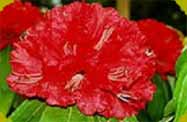|
Artemesia indica
Wild.

|
Species |
Artemesia indica
Wild. |
|
Local Name |
Titeypati (Nep) |
|
Synonym |
Artemesia vulgaris
Non.L, Roxb. |
|
Family |
Asteraceae |
|
Habitat |
A Tall aromatic herb or under shrub
often forming thicklets. Common in roadsides, hedges,
wastelands in mountainous districts of India. |
|
Distribution |
Distributed to tropical & temper-ate region at elevation
of 1700 m to 4000 m. |
|
Sikkim |
Tadong, Punney, Phodong, Samdong,
Lachen, Dikchu, Namchi,Jorethang, Mangan, Chungthang,
Rangpo-Melli, Tholung, Hee- Gyathang, Tongtsa, Nathang |
|
Out side |
West Bengal (Todeymbong, Gorubathan
to Kalimpong, Kurseong, Mungpo, Lebong, Darjeeling to
Rimbick), Bhutan (Upper Mochu), Mount Abu in Rajasthan,
in the Western ghats and from Konkan southwards to
Kerela and Khasi Hills. |
|
General |
India, Himalaya, Myanmar, Thailand, South- China, Japan. |
|
Morphological |
Perennial herb, c 0.5-1.5 m; stems
erect, grayish, puberculous to sparsely tomentose. Lower
inflorescence leaves bipinnatisect, 7- 16 x 5- 9 cm,
puberculous or glabrescent above, appressed puberculous
to tomentose beneath; primary segments 2- 3 pairs,
ovate- elliptic to lanceolate in outline, to 5 x 2 cm,
acuminate, with lowest occasionally stipuliform;
secondary segments shallower, serrate- dentate with few
deep, ovate, acuminate teeth. Capitula in broad or
narrow panicles. Involucre campanulate, 1.2- 2.5 mm
diameter; phyllaries ovate
to obovate, 1.8- 3.2 mm, sub
glabrous; outermost smaller, sparsely araneous. Female
flowers c 3- 8; corollas 0.7-1.3 mm. Bisexual flowers c
6-12; corollas 1.7- 2.2 mm. Achenes + oblong, c 1.2 mm.
|
|
Flowering |
September-December |
|
Fruiting |
October-February |
|
History |
|
|
Parts |
Whole plant, juice, leaf and flowers. |
|
Status |
Low risk |
|
Phytochemistry |
|
|
Agrocultivation |
|
|
Reference |
1. Chatterjee, Asima & Satyesh
Chandra Pakrashi (1997). The Treatise on Indian
Medicinal Plants (Vol. 5). National Institute of Science
Communication, New Delhi. 142-143.
2. Progress Report of the Project "Studies on Medicinal
Plants of Sikkim" (1998- 2001). State Council of Science
and Technology for Sikkim. |
|
Medicinal |
It is an important plant used in
multifold occasions. Medicinally used in headache,
asthma, stomachic and is an anthelmintic etc. taken bath
with bruised leaves for healthy skin. Smoke from burnt
leaves repels mosquito and insects. It stops nose
bleeding, cures measles amongst infants, also used as
antiseptics.
Whole plant: Antilithic, antiseptic,
anthelmintic, emmenagogue, febrifuge, stomachic; helps
parturition in measles, skin disease and ulcers; leaves:
haemostatic and allays burning sensation in
conjunctivitis; infusion in nervous and spasmodic
affections of asthma.
Root: Antiseptic and tonic. |
|
Ayurvedic |
|
|
Unani |
|
|
Traditional |
The juice extract of leaves is
dropped into nose to check excess nose bleeding(T.N.
Srivastava, Kapati et. al). The strong decoction of the
plants is given to children with measles for a week (Kapati,
Srivastava & Progress Report, 1999). |
|
Others |
|
|
Prepartation |
|
|
Picture |
|
|
|
|
|

Rhododendron


Amongst the many
floral treaties of Sikkim Himalaya one of the earliest ones may be
found over the genus Rhododendron (Gk. rhodo = red, dendrons = tree
). |
| |
|
|
|

Orchid


Orchid
known for their brilliance in colors, unusual shapes
attractive growth habits, variety in fragrance and
exquisite beauty can attract any nature lovers.
|
| |
|
|
|

Medicinal Plant


Sikkim
with its total geographical area of 7,096 sq km is
bestowed with a huge diversity of flora and fauna.
|
| |
|
|
|
|
|